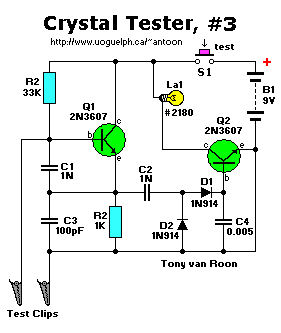
Parts List:
R1 = 33K C1,C2 = 1nF (1000pF)
R2 = 1K C3 = 0.1uF (100nF)
C4 = 0.005uF (5nF)
Q1,Q2 = 2N3607 La1 = Lamp, GE #2180
D1,D2 = 1N914 S1 = Momentary Push-button, SPST
Misc: crocodile clips, Lamp socket, 9V battery clip, wire, solder, etc.
Description:
Your 40- or 80 meter crystal isn't oscillation--what's wrong? Is it a wiring error? A solder bridge? A faulty
component? Maybe it's the crystal! A simple circuit that tests whether or not a crystal is good, this is a real
chestnut. First noticed in October 1989 issue of "Popular Electronics Magazine", but the original circuit is
credited to Mike Kaufman in Wayne Green's out-of-print book Practical Test Instruments You Can Build according
in an article in 73 Amateur Radio Today (1/92, p.22) that updates of the circuit by featuring an output for an
oscilloscope or frequency counter and uses an LED instead of the lamp shown. I am offering the orignal tester
here because it still works very well.
Transistor Q1, a 2N3607, and its associated components form an oscillator circuit that will oscillate if, and only if,
a good crystal is connected to the test clips. The output from the oscillator is then rectified by the two 1N914 signal
diodes and filtered by C1, a 1nF (1000pF) ceramic capacitor.
The positive voltage developed across the capacitor is applied to the base of Q2, another 2N3607, causing it to conduct.
When that happens, current flows through La1, causing it to glow. Since only a good crystal will oscillate, a glowing
lamp indicates that the crystal is indeed OK. No oscillation, no light. Simple as that.
Parts layout is not critical. If possible, first prototype the circuit on a breadboard to check if it works *for you*.
To check the tester, use a crystal of a frequency you can monitor on your receiver, put the tester close to the input
of the receiver and close the switch. If you hear the signal and the lamp lights, the crystal, and the tester, and
receiver all work. After that test, you can assume that if the lamp lights a crystal under test is good.
The tester should operate well for any crystal with a fundamental frequency from about 2 to 8 MHz. Harmonics are also
generated by the tester, although due to the lack of tuned circuits overtone crystals will oscillate at their fundamental
frequency.
The NTE85 is a direct replacement for the 2N3607, but any of the cheapo plastic, common, NPN transistor like a 2N2222
will do fine.
Ceramic capacitors work fine.
Any miniature 5 or 6-volt lamp will do instead of the GE #2180.
The circuit is powered by a standard 9-volt alkaline battery and the SPST push button power-switch is included to
prolong battery life.
Back to Circuits Page
Page Copyright © 1995, Tony van Roon
Article Copyright © 1989, Mike Kaufman.

